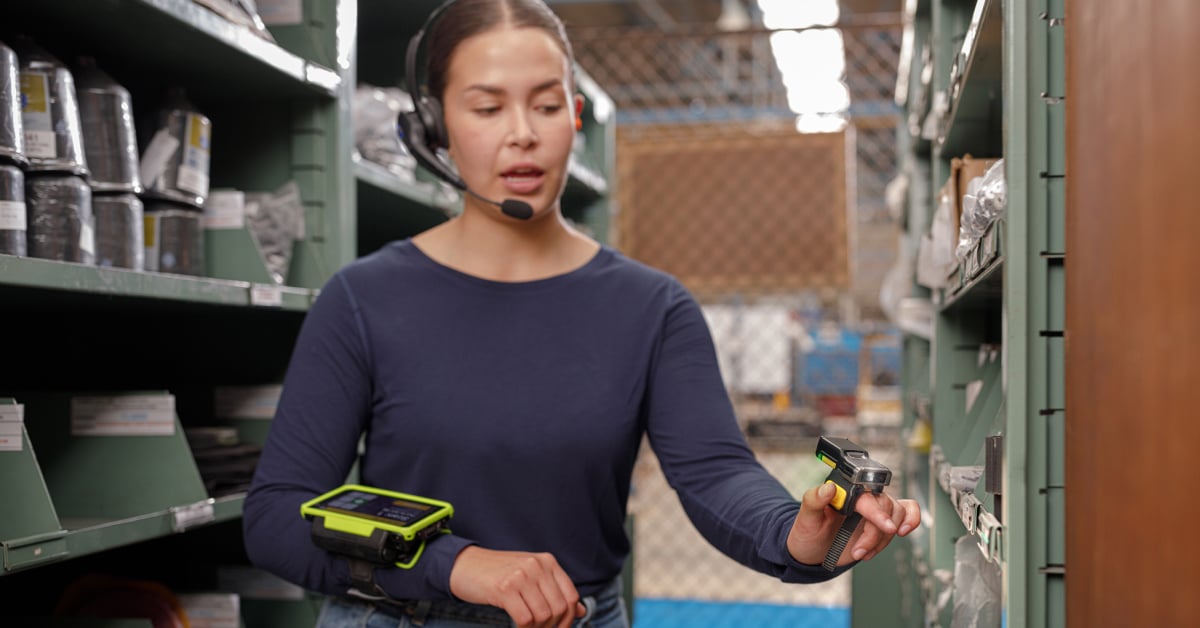Voice Picking: The Evolution of Mobile Productivity in the Warehouse
Voice-directed picking is an established method for hands-free order fulfillment in warehouses around the world. If you haven’t explored it to boost productivity, now's the time.
As it has evolved, voice-based data entry – both text-to-speech and speech-to-text – can be installed into warehouse workflows quickly and economically, without changing your existing warehouse management or other enterprise systems.
As voice-directed application deployments became mainstream, implementation was the first aspect to evolve. Early to market were implementations requiring a middleware component to handle voice to/from text transmission.
A bit later, solutions that handled voice processing on the rugged mobile device the warehouse worker was already carrying simplified deployment and reduced costs. Choosing one or the other didn’t much affect the worker’s actual experience, but the evolution made voice enablement much more accessible to distributors, third-party logistics firms and supply-chain organizations of all sizes.
Eliminating worker stop times
The goal of the voice-enabled worker experience focuses on allowing workers to have both hands free by minimizing the need to interact with the screens in their mobile application.
One among many examples: It was discovered in process consultations that warehouse workers would often stop moving to read the next instruction in their workflow. Each stop took about two seconds. That’s 12 seconds in a six-step workflow – or over two hours of stop time per worker over the course of a shift!
Voice-directed apps eliminate most, if not all, such stoppages by audibly reading the next step of the workflow to the warehouse worker. But what happened on the other side of that voice app dialogue introduced another technological evolution in the way these apps are designed.
Voice apps grow more sophisticated
Early voice apps required workers to create a “voice profile,” essentially training the voice recognition engine to understand how each individual worker spoke. Think of how words like “potato” and “schedule” are pronounced in different regional dialects of English, then consider how much more varied dialects are in languages around the world. There are lots of differences in how common words are pronounced.
Each worker creates a profile and must select it when starting his or her shift so the voice app knows which user is speaking, loads that person’s voice profile and recognizes words more accurately.
Later entrants into the voice enablement space approach language by programming into a “grammar file” only words that would be appropriate for each field of a task workflow. For example, a worker verifying successfully picking the quantity of a SKU might say “27 confirm.” The grammar file in this kind of app listened specifically for a number, followed by the specific word “confirm.”
Grammar files improve accuracy by ensuring the spoken words translated into text entries in the task workflow are only words that would be appropriate for the context of the field the worker was populating or the voice command they were giving. A worker could talk to another worker about the previous night’s football game and not have words from that conversation become errant entries in their work task.
Choose your perfect voice-app solution
Each method has its strengths. Grammar files significantly streamlines training – reducing the worker’s time learning to use the voice technology and eliminating the time needed to train the voice app to recognize each worker’s unique pronunciation of common words. This faster ramp-up time offers significant savings – especially when equipping seasonal workers with voice-picking solutions.
However, having voice profiles as a backup is one way to further reduce errors in warehouse tasks. It may not be necessary for every worker, but when a particular user is experiencing speech-recognition errors, having the option to train the system to recognize that person’s unique pronunciation is a great way to improve your perfect order rate.
Does any voice-enablement solution provide both grammar files and voice profiles? Historically, voice software vendors aligned to one method or the other. But Ivanti Velocity Voice, the evolution of our Ivanti Speakeasy voice enablement solution, provides both.
Voice picking and other voice-enabled workflows continue to increase in supply-chain operations. If you haven’t given this productivity-boosting technology a look recently, let’s talk the universal language of mobile productivity!

